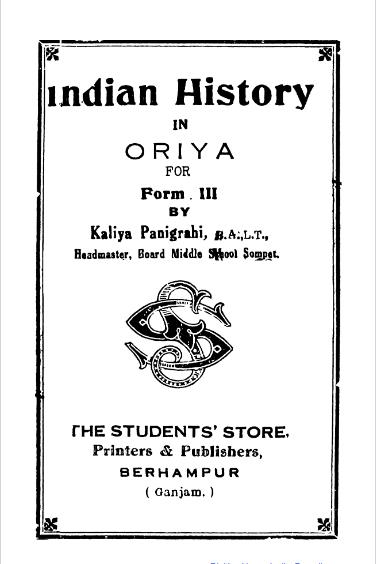In the rich tapestry of Odia literature and education, the publication of Bharata Itihasa by Kalia Panigrahi in 1934 stands as a significant milestone. This textbook, which translates to History of India, serves not only as an academic resource but also as a comprehensive exploration of India’s expansive historical narrative. As an educational tool, it aimed to foster a deeper understanding of India’s past, instilling a sense of identity and pride among students in Odisha and beyond.
Kalia Panigrahi, the author of Bharata Itihasa, recognized the vital role that history plays in shaping societal values and national consciousness. With India experiencing a transformative phase during the early 20th century, Panigrahi sought to provide students with a holistic understanding of the nation’s history, encompassing its achievements, challenges, and contributions to global civilization. His work reflects a keen awareness of the socio-political context of his time, as the country was on the brink of independence from colonial rule.
One of the defining features of Bharata Itihasa is its structure. The textbook is organized chronologically, guiding readers through various epochs of Indian history, from ancient civilizations to the modern era. This systematic approach not only aids in understanding the flow of historical events but also allows students to connect the dots between different periods, fostering a more comprehensive grasp of India’s complex narrative.
Panigrahi’s narrative style is engaging and accessible, making the textbook suitable for learners of different age groups. He employs clear language and avoids overly academic jargon, ensuring that students from diverse backgrounds can grasp the concepts presented. By weaving anecdotes and illustrative examples into his discourse, Panigrahi breathes life into historical events, encouraging students to develop a personal connection with the past.
Furthermore, Bharata Itihasa places significant emphasis on the contributions of various regions, cultures, and communities throughout India’s history. This inclusivity reflects the diverse fabric of Indian society, highlighting how different cultures have influenced and shaped the country over the centuries. By acknowledging the contributions of various ethnicities, languages, and religions, Panigrahi fosters a sense of unity and mutual respect among students, essential values in a multi-religious and multicultural society.
Another notable aspect of the textbook is its emphasis on critical thinking and analytical skills. Panigrahi encourages students to not just memorize facts but to engage with the material thoughtfully. He raises questions about historical interpretations, invites students to analyze the causes and consequences of significant events, and emphasizes the importance of understanding history as an ongoing dialogue rather than a static record. This approach equips students with the tools necessary for critical inquiry, an essential skill in any academic pursuit.
The publication of Bharata Itihasa also contributes to the cultural revival of the Odia language during a time when regional languages were often overshadowed by colonial influences. By providing a comprehensive history of India in Odia, Panigrahi reinforces the significance of regional identity and pride, ensuring that the Odia-speaking population has access to its own historical legacy.
Books Info
| Books name | Bharata Itihasa / ଭାରତ ଇତିହାସ |
| Author | Kalia Panigrahi |
| No Of pages | 151 |
| Publisher | The Student Store |
| Publication | 1934 |
| Printed At | The Student Store |
| Distributor | NA |

